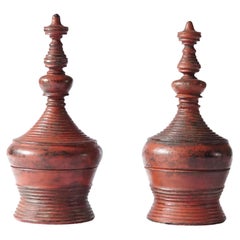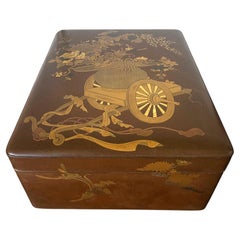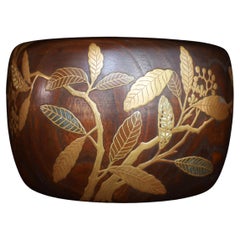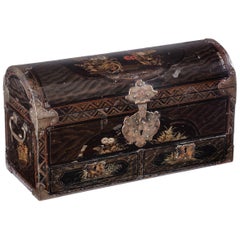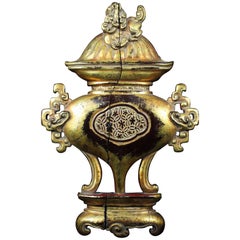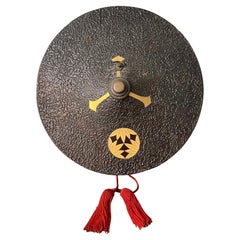Wood Lacquer
to
32
146
66
250
3
2
4
3
2
1
1
29
124
97
5
49
28
6
5
8
4
1
3
3
3
453
255
119
47
35
237
210
138
69
17
255
252
254
1
1
1
1
1
Material: Wood
Pair of Small Burmese Red& Black Lacquer Offering Vessels, "Hsun Ok", c. 1900
Located in Jimbaran, Bali
This pair of Small Lacquered Offering Vessels are know in Myanmar as "Hsun Ok". These vessels were once used to carry food and offerings to and from the monast...
Category
Early 20th Century Burmese Other Wood Lacquer
Materials
Wood, Lacquer
Japanese Lacquer Ryoshibako Document Box Meiji Period
Located in Atlanta, GA
A large Japanese lacquer box with elaborate Maki-e design from Meiji period, (mid-late 19th century). The generous size of the box was reser...
Category
19th Century Japanese Japonisme Antique Wood Lacquer
Materials
Wood, Lacquer
Set of 3 hibachi Incense burner Planters
Located in Fukuoka, JP
A rare and elegant set of three Japanese hibachi (traditional fire bowls) from the Meiji period (1868–1912), made of richly grained paulownia wood and intricately decorated with carv...
Category
20th Century Japanese Wood Lacquer
Materials
Belgian Black Marble, Copper
$2,890 / set
Fine Japanese Namban Lacquer Jewelry Casket, 17th Century
Located in Amsterdam, NL
Japanese Namban lacquer transition-style coffer with two drawers
Kyoto/Nagasaki, circa 1650
The cartouches with gilt and red decorations of leaves...
Category
17th Century Japanese Edo Antique Wood Lacquer
Materials
Cypress
China 18th Century Chinese Decoration Element in Lacquered and Gilded Wood
Located in Beuzevillette, FR
Interesting element probably coming from a lacquered and gilded wood furniture or panel representing a tripod - shaped vase with curved legs with...
Category
18th Century Chinese Qing Antique Wood Lacquer
Materials
Giltwood, Wood, Lacquer
Japanese Lacquered Samurai Jingasa Hat Edo Period
Located in Atlanta, GA
A bespoken Japanese historical hat known as Jinggasa (militant hat) that was worn by samurai in Edo period (1603-1868) circa 18-19th century. There were several subtypes of Jingasa a...
Category
19th Century Japanese Japonisme Antique Wood Lacquer
Materials
Wood, Lacquer
Japanese Lacquered Gold Maki-E Naga Fubako Meiji Period
Located in Atlanta, GA
A Japanese lacquered wood Naga Fubako (a long box used to store document or large scroll painting), circa 19th century Meiji period. The rectangular box features an unusually deep lipped lid with slightly rounded corners, a conforming lower box with bronze medallion rings with tasseled...
Category
19th Century Japanese Meiji Antique Wood Lacquer
Materials
Wood, Lacquer
English Black Lacquered and Gilt Stenciled Figural Pagoda Sewing Box, C. 1810
Located in Charleston, SC
English octagonal black lacquered and gilt stenciled figural pagoda hinged one drawer sewing box with exterior gilt stenciled dragon motif, interior gilt stenciled floral motif, orig...
Category
1810s English George III Antique Wood Lacquer
Materials
Brass
Japanese Lacquer Maki-E Scroll Box Fubako by Kansonsai Edo Period
Located in Atlanta, GA
A Japanese lacquered wood fubako (a box to store document or small scroll painting) circa late 18th century of Edo period. The rectangular box features a deep lid with rounded corners and recessed mid-edge and a lower box with two bronze medallion rings and tasseled silk ties. The surface of the fubako was elaborately decorated with hiramaki-e and a low takamaki-e on a mottled Mura-nashiji background. The motifs on the lid depict branches of Japanese pine with finely rendered needles on the lower part; on the upper part, it showcases fruited persimmon branches. Two different shades of gold fundame were used to contrast the design and augmented by scattered gold kirigane to highlight some of the leaves. The design continues and cascades down to all sides of the lid as well as the walls of the box. The two bronze medallions appear original to the box and the silk ties show significant fading from the age. This Fine fubako is signed on the lower wall "Kanshosai" in Kanji with a kao mark. All the trims were finished in gold fundame and the interiors a dense nashiji in gold.
Kanshosai is the mark of the distinguished lacquer artist Lizuka Toyo I who also signed his work "Toyosai". He was active in the second half of the 18th century during Edo period, employed by Hachisuka Shigeyoshi (1738-1801), daimyo of Awa on Shikoku Island. Although most survived work bearing his marks are inros, he was also known to decorated trays and other larger objects...
Category
Late 18th Century Japanese Edo Antique Wood Lacquer
Materials
Wood, Lacquer
Japanese Lacquer Hokai Box, 19th Century
Located in Pasadena, CA
This is a good example of a traditional Japanese Hokai shell storage box for the Kai-awase game. This box is well-detailed in chased brass appliques and makie. The box is in overall ...
Category
Late 19th Century Japanese Japonisme Antique Wood Lacquer
Materials
Wood, Lacquer
$1,175 Sale Price
24% Off
Japanese Lacquer Box, Kogo, Tale of Genji, Edo Period, early 19th century, Japan
Located in Austin, TX
A fine Japanese small lacquer box for precious incense, kogo, Edo period, mid 19th century, Japan.
The small box of gold lacquer and wonderfully dec...
Category
Early 19th Century Japanese Edo Antique Wood Lacquer
Materials
Pewter
English Black Lacquered and Gilt Stenciled Figural Pagoda Tea Caddy, Circa 1810
Located in Charleston, SC
English octagonal hinged black lacquered tea caddy with gilt stenciled figural pagoda, decorative foliage motif, original hand chased lidded in...
Category
Early 1800s English George III Antique Wood Lacquer
Materials
Pewter
Kobako in natural wood of a frog under a willow tree
Located in PARIS, FR
Small kobako in natural wood made of a circular cross section, lacquered using both the maki-e technique and a transparent finish that grant a glossy finish to the bark. The composit...
Category
Early 20th Century Japanese Taisho Wood Lacquer
Materials
Gold
Japanese Gilt Takamaki-E Tabako-Bon, C. 1850
Located in Chicago, IL
This box with many drawers is a Japanese tabako-bon, or 'tobacco tray,' used to store tobacco and smoking accessories. Believed to have evolved from the t...
Category
Mid-19th Century Japanese Meiji Antique Wood Lacquer
Materials
Brass
Pair of Japanese Hibachi with Inlaid Bamboo Motif
Located in Fukuoka, JP
A beautifully matched pair of Japanese hibachi (traditional fire bowls) from the Meiji period (1868–1912), showcasing exceptional craftsmanship and refined aesthetics. Each vessel is...
Category
Early 20th Century Japanese Taisho Wood Lacquer
Materials
Wood
Fine Japanese Hibachi Lacquer with Inlays Meiji Period
Located in Atlanta, GA
A fine Japanese wood Hibachi with copper insert circa 1900-30s end of Meiji to Taisho Period. It can be used as a unique planter or to showcase a...
Category
Early 20th Century Japanese Meiji Wood Lacquer
Materials
Copper
Japanese Taishō Gold and Red Lacquer Hexagonal Planters with Reeded Cartouches
Located in Yonkers, NY
A pair of Japanese Taisho period gold and red lacquer hexagonal planters from the early 20th century, with recessed reeded cartouches. Hailing from the Taisho period in Japan (1912-1...
Category
Early 20th Century Japanese Taisho Wood Lacquer
Materials
Wood
Four Japanese Lacquered Sake Cups Meiji Period
Located in Atlanta, GA
An assemble of four lacquerware sake cups from Meiji period Japan circa late 19th century. The shadow cups on an elevated stem were used by the nobles during ...
Category
Late 19th Century Japanese Meiji Antique Wood Lacquer
Materials
Wood, Lacquer
$2,000 / set
Japanese Lacquered Maki-e Fubako Edo Period
Located in Atlanta, GA
A Japanese lacquered wood fubako (a box used to store document or small scroll painting), circa second half of 19th century late Edo period. The rectangular box features an unusually deep lipped lid with slightly rounded corners, a conforming lower box that is almost entirely covered by the lid which has two bronze medallion rings with tasseled...
Category
19th Century Japanese Edo Antique Wood Lacquer
Materials
Wood, Lacquer
END OF THE 19th CENTURY PAIR OF JAPANESE VASES
Located in Firenze, FI
Beautiful pair of wooden vases lacquered in an elegant shade of blue, and decorated with light wood inlays and golden finishes. The inlays depict delicate floral and bird motifs, cre...
Category
Late 19th Century Japanese Meiji Antique Wood Lacquer
Materials
Wood
$3,021 / set
Large Chinese Export Black Lacquer & Gilt Decorated Sewing Box C. 1860
Located in Atlanta, GA
This exceptional mid-19th century Chinese Export sewing box is a stunning example of intricate craftsmanship and artistry. The large rectangular box is crafted from wood, finished in...
Category
Mid-19th Century Chinese Chinese Export Antique Wood Lacquer
Materials
Wood, Giltwood, Lacquer
$1,560 Sale Price
20% Off
Modern Japanese Lacquered Box. Mid 20th Century. H 5" D 12-1/4".
Located in Branford, CT
Very fine artist made modern Japanese lacquered box.
Circa 1960.
Category
Mid-20th Century Japanese International Style Wood Lacquer
Materials
Bentwood
Japanese Antiques A paulownia lacquer Makie brazier with a deer and a lantern
Located in Niiza, JP
φ310× 205(H) [mm]
Box size: φ340×240㎜ 4㎏
Lovely design
A Kasuga lantern with a cute male and female deer in raised lacquer.
The grey parts are made with lead.
The window of the lant...
Category
19th Century Japanese Antique Wood Lacquer
Materials
Wood
Large Vintage Japanese Maki-e Lacquer Kimono Tray
Located in Atlanta, GA
A large square lacquer presentation tray (likely for kimono) predated 1950 of the Showa period. Elaborately decorated with Maki-e that depicts the prunus blossom, bamboo and needle p...
Category
1940s Japanese Japonisme Vintage Wood Lacquer
Materials
Wood, Lacquer
Two Palembang Peranakan Lacquerware Bridal Boxes and a Tray
Located in Amsterdam, NL
Two Palembang Peranakan lacquerware bridal boxes and a tray
South Sumatra, Palembang, lacquer work by Chinese Peranakan artisans, mid 20th century
Woo...
Category
1950s Indonesian Vintage Wood Lacquer
Materials
Wood, Lacquer
A Japanese export lacquer box with depiction of the Grand Hotel, Yokohama
Located in Amsterdam, NL
Meiji period, circa 1873-1887
The black lacquered box decorated in maki-e and hiramaki-e gold, with on the lid a European style building complex and several Japanese and European figures walking along a street in the foreground. The sides are finely decorated with several insects and the inside with several compartments and nashiji decoration.
H. 7.4 x W. 29 x D. 25.7 cm
After the Americans forced Japan to open their harbours to the outside world and take part in international treaty and trade around the mid 19th century, the formerly feudal society rapidly changed. Japan was now focussing on an industrial future. One of the major international ports was Yokohama with its foreign embassies and warehouses - which attracted a great number of visitors of all sorts. For the higher society visiting Japan for the first time a new and ‘Western’ hotel had to be realised; hence the construction of The Grand Hotel on Kaigandori.
The hotel was opened on August 16, 1873 (Meiji 6) and was soon considered the height of Western culture and elegance in Japan. The building probably depicted on this box, designed by American architect Richard P. Bridgens (リチャード・ブリジェンス, 1819 -1891), is the original hotel...
Category
19th Century Japanese Antique Wood Lacquer
Materials
Gold
Japanese Antiques Lacquer craftsman's workbench, Abstract Painting
Located in Niiza, JP
Material: mainly Cedar board
A workbench used by lacquer craftsman.
Through years of use, natural layers of lacquer have formed, giving it a beautiful appearance like an abstract pa...
Category
19th Century Antique Wood Lacquer
Materials
Wood
Rare pair of Japanese Nagasaki Export Lacquered Wood Knife Boxes
Located in Stamford, CT
Rare pair of Japanese Nagasaki Export lacquered wood knife boxes with mother-of-pearl inlay of flowers and birds, now converted to letter boxes...
Category
Early 19th Century Japanese Anglo-Japanese Antique Wood Lacquer
Materials
Wood
Pair of Large Antique Japanese Hokai Lacquer Boxes
Located in Atlanta, GA
A pair of Japanese lacquer lidded Hokai boxes with chased brass hardware and original ropes. Hokai boxes are traditionally used in Japan to store and carry s...
Category
Early 20th Century Japanese Japonisme Wood Lacquer
Materials
Wood, Lacquer
Japanese Maki-e Lacquer Tray Box with Cutout Design
Located in Atlanta, GA
A Japanese lacquer box with lid and an inner tray decorated with Maki-e on a dense nashiji background. The fine box was likely made circa 1920-30s...
Category
1920s Japanese Taisho Vintage Wood Lacquer
Materials
Wood, Lacquer
Set of Four Japanese Maki-e Lacquered Pedestal Dishes
Located in Atlanta, GA
A set of four Japanese shallow footed bowls or dishes in red lacquer with predominantly gold Makie design circa 1920s-1930s Taisho period. Each was decorated with hiramakie painting of different motifs, mostly gold, black and pewter color. One with a temple drum...
Category
1920s Japanese Japonisme Vintage Wood Lacquer
Materials
Wood, Lacquer
One Chinese Black Lacquer Rectangular Lidded Jewelry box, Late 19th Century
Located in ARMADALE, VIC
One Chinese Black Lacquer Rectangular Lidded Jewelry box, Late 19th Century
Provenance: Private Melbourne Collection.
Dimensions: Width: 37cm Height: 10.5cm Depth: 20.5cm.
Category
Late 19th Century Chinese Qing Antique Wood Lacquer
Materials
Wood
Antique Japanese Lacquered Incense Box Kobako Ex-Christie's
Located in Atlanta, GA
An old Japanese lacquered small box likely used to contain incense powder called Kobako, circa Momoyama to early Edo period (16-17th century). The rectangular form box with a fitted ...
Category
17th Century Japanese Japonisme Antique Wood Lacquer
Materials
Lead
1937 Japanese Fish Sea Bream Carved Design Wooden Tray
Located in Fukuoka, JP
A Beautiful Japanese Wood Carving Tray with Carp Design.
This beautiful Japanese wood carving tray is a stunning example of Japanese craftsmanship. It is dated 1937 and is in good o...
Category
20th Century Japanese Taisho Wood Lacquer
Materials
Wood, Lacquer
Set Antique Chinese Lacquered Wooden Plates
Located in New York, NY
A matched set of Antique Chinese Lacquered Wooden Plates. Sculpted cut Elm wood sections joined together with wooden pins, wire banding and lacquer from the Qing Dynasty. A rare set of Antique Chinese Lacquered Plates...
Category
1880s Chinese Qing Antique Wood Lacquer
Materials
Wood
Superb incense burner with Peacock design. Late 19-early 20th century.
Located in Fukuoka, JP
This exquisite late 19th-century Japanese incense burner is a stunning example of traditional craftsmanship. The rounded rectangular form is meticulou...
Category
Late 19th Century Japanese Antique Wood Lacquer
Materials
Wood
Antique Authentic Chinese Carved Ornate Wood Altar Shrine
Located in Chicago, IL
Antique Authentic Chinese Carved Ornate Wood Altar Shrine
A Chinese altar is perfect for worship or displaying your treasured items. The display space is ...
Category
Early 20th Century Chinese Rustic Wood Lacquer
Materials
Wood, Lacquer
Chinese Lacquered Octagonal Nesting Bowls
Located in Bridgeport, CT
A decorative and well made nested group of five Octagonal Lacquered Wood Trays. In a fine and smooth medium honey tone lacquer with a hint of Cinnebar. The trays are in graduated siz...
Category
20th Century Asian Ming Wood Lacquer
Materials
Wood
Rhino Contemporary Japanese Lacquer Art by Someya Satoshi
Located in Atlanta, GA
Japanese Lacquer Rhino Sculpture by Someya Satoshi (1983-). A hand-molded lacquer sculpture that depicts a fantasy beast "Rhino". The artist uses century-old traditional techniques and symbols but with an innovative contemporary energy that borders mysticism, shamanism and surrealism. Found objects were equally treated as part of the meticulous designs as the elaborate Maki-e and shell inlays.
According to the press of Honolulu Museum of Art: "Someya Satoshi has been described as “one of the most significant contemporary lacquer artists working in Japan today.” (Japan Times, 12 Dec. 2013) His work combines objects of daily use, such as bathing buckets, serving trays, and soup bowls, with a wide array of natural materials, including animal bones, horns and antlers, sand, stones, leaves and branches. In the process, he implements a range of traditional lacquer methods passed down from pre-modern eras, such as the kanshitsu or “dry lacquer” technique, the origins of which date to Japan’s Nara period (710–784). After creating his forms, he embellishes them with designs inspired by calligraphy, traditional Japanese textile patterns, and even contemporary manga or comic books. His work defies ordinary definitions of lacquer art and successfully challenges the perceived limits of this extremely difficult and, in some ways, most conservative of traditional Japanese art forms".
His work was exhibited in US such as Honolulu Museum of Art, Minneapolis Institute of Art, Morikami Museum etc. For a complete resume of the artist, see the artist's page in Imura Art Gallery.
Reference: For a very similar Bull Sculpture see Hard Bodies Contemporary Japanese Lacquer...
Category
Early 2000s Japanese Japonisme Wood Lacquer
Materials
Rope, Wood, Lacquer
massive Thai Buddha Head, 19th c.
Located in New York, NY
gold decorated Buddha head; overall with stand: 36in(H) x 20in(L) x 11.5in(D); Buddha head only: 33in(H) x 17in(L) x 11in(D)
Category
Late 19th Century Thai Antique Wood Lacquer
Materials
Wood
Pair of Japanese Lacquer and Mother-of-Pearl Inlaid Knife Urns, circa 1800-1815
Located in Amsterdam, NL
A rare pair of Kyoto-Nagasaki style lacquer and mother-of-pearl inlaid knife urns
Edo period, early 19th century
Measures: Height 71 x diameter 30 cm
?Formed as urns with vertically lifting covers and elongated finials, revealing fitted green velvet lined interiors for knives, decorated overall with birds, flowering stems, faux-fluting and oval panels with landscapes. The square plinth is raised on four bracket feet. Inside the lifting cover of one of the urns are Japanese characters, supposedly indications of some code by the craftsman.
A closely related knife urn, now in the collection of the Peabody Essex Museum, Salem (inv. E 73115), was acquired in Nagasaki by Captain Samuel Gardner Derby of the Margareth of Salem in 1801. Captain Gardner Derby traded in Nagasaki under charter from the VOC (Vereenigde Oostindische Compagnie), the Dutch East India Company. Between 1797 and 1814 Holland was occupied by the French and from 1811 until 1816 Java by
the English. During these periods practically no Dutch shipping was possible between Holland and Batavia (Jakarta) or between Batavia (Jakarta) and Nagasaki. To maintain a minimum amount of shipping between Batavia (Jakarta) and Nagasaki, between 1797 and 1807, the VOC chartered mainly American ships. American captains and officers ordered and bought mainly lacquered furniture in an American-English style, completely different from what the Dutch up till then had ordered. The present knife urns were possibly also ordered and acquired by Captain Gardner Derby during his stay in Deshima/Nagasaki in 1801.
Another similarly neoclassical shaped knife urn in the collection of the Ashmolean Museum Oxford (inv. 1996.17) appears to be signed by woodworker Kiyotomo koreo tsukuru (Kiyomoto made this). The same name, together with an address in the Sanjo-Teramachi District of Kyoto, has been found inside a fragmentary urn in a private collection. This is an indication that European-style furniture was not only lacquered in Japan but made there as well. This undoubtedly is not only true for knife-urns, but all European- style furniture lacquered in Japan after circa 1800 was made by Japanese furniture makers...
Category
Early 19th Century Japanese Anglo-Japanese Antique Wood Lacquer
Materials
Brass
Chinese Export Lacquered and Mother-of-Pearl Chess Board from 19th with a Table
By Gold China
Located in Madrid, ES
Chinese Export lacquered and mother-of-pearl chess board from 19th with a table carved wood stand.
Size: 58 x 58cm and 73 cm high
Very good condition.
Category
19th Century Chinese Chinese Export Antique Wood Lacquer
Materials
Wood
19th Century Red Lacquer Tray with Rabbit Running Over Waves Under Full Moon
Located in Hudson, NY
19th century Japanese red lacquer tray with rabbit running over waves under full moon. Mingei style painting, the imagery of this tray is bas...
Category
Early 19th Century Japanese Edo Antique Wood Lacquer
Materials
Wood, Lacquer
Chinese Black Lacquered Wood Box - Imperial Dragons - Ming Period Wanli 17th
Located in Beuzevillette, FR
Magnificent box Imperial jewelry box in black lacquered wood decorated with dragons.
This wonderful box is lacquered on a black background with patt...
Category
17th Century Chinese Ming Antique Wood Lacquer
Materials
Wood
Japanese Antique Lacquer Natsume (box for matcha powder) Automne Flowers 1980s
Located in Paris, FR
This is a box for the matcha powder using while tea ceremony in Japan.
It is called 'Natsume'. It is made with wood. The design is some automne flowers and it is all hand painted. Th...
Category
1980s Japanese Showa Vintage Wood Lacquer
Materials
Wood, Lacquer
Pair of Japanese Black Lacquer Ikebana Flower Troughs by Teshigahara Sofu
By Sōfu Teshigahara
Located in Prahran, Victoria
A distinctive pair of Japanese black lacquer ikebana flower troughs. The two sections, designed in harmony, allow a generous opportunity for creative arr...
Category
20th Century Japanese Wood Lacquer
Materials
Wood
19th Century Chinese Black Lacquer Work Box
Located in Tampa, FL
The 19th century Chinese black lacquer work box has most of the interior with handles on each side. With dragon feet
Category
Late 19th Century Chinese Antique Wood Lacquer
Materials
Wood, Lacquer
1800s Russian Lacquer Box Philosopher
Located in Vienna, AT
In this ad you get the chance to buy a beautiful hand-painted Russian lacquer box from the 1800s. It is cylindrical in shape, slightly curving in...
Category
18th Century Russian Antique Wood Lacquer
Materials
Bentwood
19th Century Antique Chinese Inlay Tin Coconut Big Bowl
Located in Brea, CA
Antique 19th century Chinese tin coconut big bowl with mark, diameter 8.5inch, high 3.5 inch.
Category
Late 19th Century Chinese Qing Antique Wood Lacquer
Materials
Coconut
A Chinese Red Lacquer Lidded Jewelry Box, Early 20th Century
Located in ARMADALE, VIC
A Chinese Red Lacquer Lidded Jewelry Box, Early 20th Century
Provenance: Private Australian Collection.
Dimension: Width: 19cm Height: 22.5cm Depth: 21cm.
Category
Early 20th Century Chinese Qing Wood Lacquer
Materials
Wood
$450 Sale Price
50% Off
Japanese Colonial Nagsaki Lacquer Box with Depiction of Amsterdam, 1830-1840
Located in Amsterdam, NL
An important Japanese lacquer box with a view of The 'Nieuwe Stadsherberg Van Amsterdam
Nagasaki, Edo-period, 1830-1840
The black lacquered wood box, decorated in gold and inla...
Category
Early 19th Century Japanese Antique Wood Lacquer
Materials
Mother-of-Pearl, Wood
Japanese Antique Lacquer Natsume (box for matcha powder) Red Boat 1980s
Located in Paris, FR
This is a box for the matcha powder using while tea ceremony in Japan.
It is called 'Natsume'. It is made with wood. The design is a boat and it is hand painted. The material is with...
Category
1980s Japanese Showa Vintage Wood Lacquer
Materials
Wood, Lacquer
19th Century Chinoiserie Gilt Painted Box
Located in New York, NY
A 19th century Chinese chinoiserie gilt painted box. Lacquer work box of very high quality.
Beautifully painted.
Category
Early 19th Century Chinese Qing Antique Wood Lacquer
Materials
Wood
19th Century Chinese Fragment as a Mirror
Located in Tampa, FL
An early 19th century red lacquer with gold accents Chinese fragment with gold courting scenes converted into a mirror. Brass holder for hanging.
Category
Early 19th Century Chinese Antique Wood Lacquer
Materials
Wood, Lacquer
Fine 17th Century Japanese Export Black and Gold Lacquered Pictorial-Style Dish
Located in Amsterdam, NL
A fine Japanese export black and gold lacquered pictorial-style dish Nagasaki or Kyoto, 1680-1720
The dish with wide flat rim of Keaki wood (Zelkova species) in black lacquer with...
Category
17th Century Japanese Edo Antique Wood Lacquer
Materials
Gold
Antique Burmese Lacquer and Gilt Buddha Head Sculpture
Located in Atlanta, GA
An antique lacquered and gilt wood buddha head on a custom wood stand circa early 19th century. The statue was finely sculpted with a wood core and th...
Category
Early 19th Century Burmese Archaistic Antique Wood Lacquer
Materials
Lacquer, Wood
Japanese Black Lacquer & Gold Sake, Champagne Flutes or Wine Stemware, Set of 6
Located in New York, NY
A very beautiful set of six (6) Japanese black lacquer and gold sake, Champagne flutes, or wine stemware glasses, circa 20th century, Japan. Each with a different botanical design in...
Category
Early 20th Century Japanese Wood Lacquer
Materials
Wood
19th Century Qing Dynasty Red Lacquered Blanket Chest with Iron Hardware
Located in Yonkers, NY
A Chinese Qing dynasty period red lacquered blanket chest from the 19th century, with iron hardware. This exquisite Chinese Qing dynasty period blanket chest, dating back to the 19th...
Category
19th Century Chinese Qing Antique Wood Lacquer
Materials
Iron
Japanese Antique Lacquer Natsume (box for matcha powder) Plum 'UME' 1980s
Located in Paris, FR
This is a box for the matcha powder using while tea ceremony in Japan.
It is called 'Natsume'. It is made with wood. The design is plums (Japanese apricot 'UME') and it is hand paint...
Category
1980s Japanese Showa Vintage Wood Lacquer
Materials
Wood, Lacquer
19th Century Chinoiserie Boxes
Located in Los Angeles, CA
Pair of intricately hand-painted, lacquered, parcel-gilt, occasional boxes.
Category
19th Century English Antique Wood Lacquer
Materials
Lacquer, Wood
$3,900 / set
Recently Viewed
View AllMore Ways To Browse
Large Japanese Lacquer Box
Meiji Japan Tray
Lacquered Japanese Bowl
Japanese Comb
Japanese Lacquered Miniature
Japanese Red Lacquer Tray
Japanese Lacquer Plaque
Large Cinnabar
Chinese Carved Cinnabar Red Lacquer
Korean Mother Of Pearl Furniture
Korean Mother Of Pearl
Japanese Lacquer Ware
Antique Chinese Cinnabar Lacquer
Japanese Lacquered Trunk
Chinese Red Lacquer Tray
Red Lacquer Ware
Burmese Lacquer Trays
Japanese Makie Lacquer
